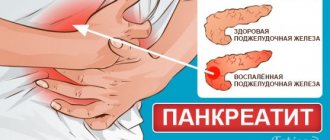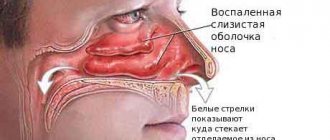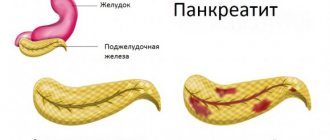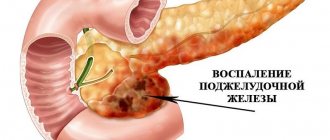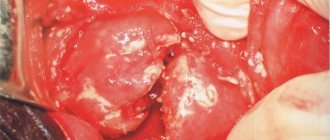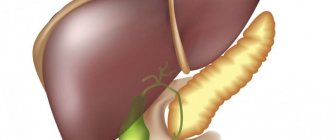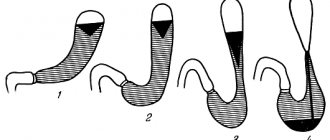Destructive pancreatitis, which occurs in an acute form, is one of the most dangerous pathological processes that can occur in the human body. Another name for this disorder is pancreatic necrosis. This destructive process leads to irreversible death of pancreatic tissue and disruption of the gastrointestinal tract.
The destructive process leads to irreversible death of pancreatic tissue.
This pathological condition often causes the development of severe complications and even with timely assistance, death is possible.
Causes of the disease
Acute destructive pancreatitis develops due to intensive production of enzymes, as a result of which the pancreas destroys itself. Aggressive pancreatic enzymes are:
- lipase,
- trypsin,
- amylase.
These substances destroy proteins, fats and carbohydrates, and protein is the main structural element of all body tissues. Normally, enzymes enter the duodenum, where they participate in the digestion of food. When the pancreas becomes inflamed—pancreatitis—enzyme substances remain in it.
The following reasons can cause a destructive inflammatory process:
- long-term alcohol abuse,
- acute intoxication with heavy metal salts, insect and snake venom,
- organ injury,
- blockage of the biliary tract,
- helminthiasis,
- taking certain medications
- infectious diseases.
Pancreatitis develops within 24 hours against the background of massive exposure to the causative factor.
Forecasts
The development of a destructive form of pancreatic damage to a parenchymal organ is one of the most dangerous pathologies, localized in the peritoneum and requiring urgent medical treatment. Neglected cases, if not promptly referred to specialists, usually end in the death of the patient.
This pathology can develop in the body of any person who does not follow the rules of a healthy lifestyle. Smoking, alcohol, poor diet, snacking on the run, ignoring the development of infectious diseases in the body - all this can lead to the development of pancreatic necrosis of the pancreas. To prevent the development of pathology in a timely manner, it is necessary to visit a gastroenterologist’s office every six months, who will be able to conduct the necessary diagnostics and, if any violations are detected, prescribe the necessary treatment regimen.
Bibliography
- Nesterenko, Yu. A. Diagnosis and treatment of destructive pancreatitis. M. BINOM-Press, 2004
- Gorsky V.A. et al. Antimediator therapy in the complex treatment of acute destructive pancreatitis. Journal named after N.I. Pirogova, surgery, 2010, No. 3, pp. 54–61.
- Vinnik Yu.S., Miller S.V., Mukhin S.P. The use of laparoscopic interventions for destructive forms of acute pancreatitis. Endoscopic surgery 1999 No. 3 pp. 46–47.
- Barkhatov I.V. Laparoscopy and direct pancreatoscopy in the diagnosis and treatment of acute pancreatitis: Abstract of the dissertation of Ph.D. honey. Sci. Chelyabinsk, 2003
- Bozhenkov, Yu. G. Practical pancreatology. Guide for doctors M. Med. book N. Novgorod Publishing House NGMA, 2003
- Savelyev V.S., Gelfand B.R., Gologorsky V.A. and others. Destructive pancreatitis in the light of modern ideas about sepsis. Annals of Surgery 1999 No. 5 pp. 26–29.
- Burnevich S.Z., Gelfand B.R., Orlov B.B. and others. Destructive pancreatitis: current state of the problem. Bulletin of surgery 2000 No. 2 pp. 116–122.
- Nazyrov F.G., Vakkasov M.Kh., Akilov Kh.A. and others. Diagnosis and complex treatment of destructive pancreatitis. Medical Journal of Uzbekistan 2000 No. 2 pp. 6–9.
https://youtu.be/ePw_go6vIoE
Forms and stages of destructive pancreatitis
The destructive form of pancreatitis has several varieties. They are determined by the volume of damage to the gland tissue:
- finely focal,
- medium focal,
- macrofocal,
- total.
The latter form is the most severe and has the highest mortality rate. Death can occur in the first hours of illness due to failure of all organs. The second option for an unfavorable outcome is late and occurs due to purulent complications.
The disease goes through several stages in its development:
- The first is enzymatic. There is an intensive production of enzymes that accumulate in the gland tissue and begin to destroy cell walls. The stage lasts for three days.
- Reactive. The inflammatory process increases and tissue destruction continues. The stage lasts 7-10 days.
- Sequestration. At this stage, it is possible to limit the inflammatory process through the formation of cysts or complete destruction of the pancreas.
Destructive life-threatening complications of pancreatitis develop at the third stage.
general characteristics
This disease has a high mortality rate, and this is especially true for patients with severe complications. Death can occur either in the first or fourth week of disease progression. In the second week, death rarely occurs, occurring in most cases in older people. The disease has 3 stages of development:
- At early stage 1, necrosis forms in the organ. The period lasts 3 days, it is also called the enzymatic phase. The onset of a “light period”, which is characterized by a decrease in pain and subsidence of symptoms.
- Stage 2 begins from the second week of the disease, the second name is the reactive phase.
- At stage 3, the patient may recover or purulent formations may appear. This depends on the neglect of the case and on the timely implementation of treatment measures.
Clinical picture
The disease is characterized by a sudden onset and a rapid increase in all symptoms. The first manifestation of pancreatitis is pain. It occurs suddenly and has an intense paroxysmal character. The localization of pain depends on the affected part of the organ - in the left side, in the stomach area, closer to the right hypochondrium. With total damage, the pain has a girdling character. Pain is associated with irritation of nerve endings by enzymes and breakdown products.
The second mandatory sign is frequent vomiting. It does not depend on food and liquid intake. At first, the vomit contains food debris, then only bile. A person does not feel better after vomiting. The appearance of vomiting is due to intoxication and digestive disorders.
Due to the lack of enzymes that do not enter the intestines, digestion suffers. This is manifested by increased gas formation and diarrhea. The stool becomes semi-liquid and acquires a shiny hue.
Vomiting and diarrhea lead to dehydration. The person experiences severe thirst, the skin becomes dry and pale. Upon examination, a rapid heartbeat and decreased blood pressure are detected.
Symptoms
Often, clinical manifestations of destructive pancreatitis occur after ingestion of fatty foods or alcohol. Already at the first stage of development of the pathological process, the patient develops acute pain syndrome. The patient tries to pull his knees towards his stomach, because in this case the intensity of the discomfort may decrease. Painful sensations may be girdling in nature. Characteristic manifestations of the pathological condition include:
- nausea;
- severe vomiting that does not bring relief;
- diarrhea;
- flatulence;
- bloating;
- complete loss of appetite.
Characteristic manifestations of the pathological condition include bloating.
As the disease progresses, patients become severely dehydrated. The patient complains of dry mouth. The skin takes on an unhealthy appearance. The patient is rapidly losing weight. The following symptoms may appear:
- increased body temperature;
- facial redness;
- increased heart rate;
- bluish spots on the buttocks and abdomen;
- dyspnea;
- yellowing of the sclera of the eyes;
- an unreasonable feeling of fear.
This releases a large amount of toxins into the bloodstream. If pancreatitis is accompanied by purulent complications, inflammatory damage to the peritoneal cavity and signs of sepsis may appear. In the later stages of the pathological process, patients often lose consciousness.
Diagnostic methods
The diagnosis of the destructive acute form of pancreatitis is determined by the totality of the patient’s complaints, characteristic symptoms, and research results. To avoid dangerous complications, the diagnosis must be made within two days from the moment of hospitalization.
Table. Algorithm for diagnosing the destructive form of pancreatitis
| Examination method | Result |
| Blood tests | Signs of acute inflammation are an increase in ESR and the number of leukocytes. Signs of destructive damage to the pancreas - a significant increase in alpha-amylase |
| X-ray of the chest and abdomen | Allows you to identify fluid in the lungs, gas accumulation in the intestines |
| Ultrasound | One of the most important methods for diagnosing pancreatitis, it allows identifying the disease in 85% of patients |
| Laparoscopy | An important examination method is laparoscopy, which allows you to directly examine the gland, determine the extent of its damage and the degree of damage to other organs. It is carried out by introducing probes with a video camera and a lamp into the abdominal cavity |
| CT scan | The most reliable diagnostic method, indicative in 95-100% of cases. Provides the most complete information about the condition of the gland and adjacent organs, the abdominal cavity |
The diagnostic method is selected taking into account the severity of the patient’s condition.
Treatment
Treatment of destructive pancreatitis is carried out only in the intensive care unit. The patient requires infusion therapy to relieve intoxication and normalize the water-salt balance. A solution of sodium chloride, glucose, and rheopolyglucin is administered intravenously.
In severe cases of pancreatitis, plasmapheresis and hemosorption are indicated - methods of purifying the blood of toxins and enzymes. To influence the cause of the disease, drug therapy is prescribed.
Diet
In the first three days, strict rest for the pancreas is necessary. This is achieved through complete fasting. You are only allowed to drink water. To provide the body with the necessary nutrients, parenteral feeding is prescribed. It consists of intravenous administration of protein-glucose solutions.
As the inflammatory-destructive process subsides, nutrition according to diet No. 5p is allowed. The diet should be as gentle as possible. The following products are excluded:
- fatty meat, fish,
- dairy products,
- bakery,
- pasta,
- any sweets,
- tea and coffee,
- fresh fruits and vegetables,
- legumes.
Initially, the diet consists of viscous porridges with water, vegetable soups, and boiled dietary meat. The number of permitted products is gradually increasing.
After an illness, a person has to follow a diet for life, since the pancreas is not completely restored.
Medicines
The purpose of prescribing medications is to suppress the secretory function of the pancreas in order to stop the process of its self-destruction. Drugs are also prescribed to influence causative factors:
- Antisecretory drugs – Gordox, Octreotide, 5-fluorouracil. Medicines are prescribed intravenously, the number of applications is determined by the severity of the patient’s condition. The drugs suppress the production of enzymes by the pancreas, stopping the destructive process.
- Antibacterial agents. They are used when the disease is infectious, as well as to prevent the addition of secondary flora. Drugs from several groups are prescribed - aminoglycosides, protected penicillins, fluoroquinolones (Pefloxacin, Ciprofloxacin, Sulbactam).
- Antispasmodics – No-shpa, Papaverine. Help eliminate pain. They are prescribed intramuscularly, then orally in tablet form.
The duration of drug therapy is determined by the severity of intoxication and the severity of the general condition. On average, the course of treatment is 14-21 days.
The administration of enzyme preparations (Mezim, Pancreatin) in the acute form of the disease is strictly prohibited.
Folk remedies
The use of folk remedies in acute destructive processes is prohibited. Any self-medication aggravates destructive processes in the pancreas, increasing the risk of an unfavorable outcome.
After eliminating acute inflammation and stabilizing the condition, it is allowed to use some herbal medicines:
- collection No. 1 – burdock root, wormwood, chamomile, calendula, string,
- collection No. 2 – dill seeds, mint, chamomile, hawthorn,
- collection No. 3 – knotweed, St. John's wort, birch leaves.
All components are taken in equal quantities and mixed. For 10 g of the mixture you will need a glass of boiling water. The herb is brewed, allowed to brew, then drunk a quarter glass before each meal.
Potato and carrot juice helps alleviate inflammation. Vegetables are peeled and grated. Then squeeze out the juice and take it every time before meals. Continue treatment for 7 days.
Breakfast and dinner can be replaced with buckwheat and kefir. To prepare, you need to take a glass of buckwheat and rinse thoroughly. Pour a liter of kefir over the cereal and leave overnight. Eat half the mixture in the morning, half in the evening. Do this for 10 days.
Oatmeal jelly softens discomfort. You need to take 100 g of oats, rinse well and soak in warm water. After a day, grind the mixture in a blender and boil. Drink the entire amount during the day. Continue treatment for two weeks.
Destructive behavior: what is it in psychology
In psychology, we most often talk about destructive thinking and behavior. This behavior, which deviates from medical, social and other norms, endangers and destroys the life of an individual. It is realized through destructive actions. These are the words, actions, actions or inactions of a person, leading to negative consequences for him or his environment, the entire society.
Due to destructive attitudes, a person’s perception and ability to evaluate himself and situations are distorted, and emotional disturbances arise. These features lead to maladjustment and desocialization of the individual.
Examples and types
American psychologist Eric Berne named two directions of destructive behavior: inward and outward.
Examples of toxic behavior that is directed outward:
- moral or physical destruction of another person;
- aggressiveness and hostility in communication;
- extremist actions aimed at destroying individual groups or the entire society;
- vandalism and other actions that destroy cultural heritage or any other objects;
- killing of animals, deforestation, pollution of nature, that is, destruction of the environment.
Examples of self-destructive, self-destructive behavior:
- dependencies of any type;
- sexual promiscuity, risky behavior and other deviations;
- delinquent behavior (criminal);
- suicide and self-harm.
Destructive behavior occurs in every person, usually during a crisis period, for example, in adolescence. It destroys the personality or its individual components. Negative changes in character and temperament, needs and value system, interests, and motives are noticeable. An individual with a tendency to destruction is characterized by inadequate self-esteem and weak willpower.
Analysis of destructive behavior helps to understand its direction. It, in turn, helps to determine the motive and stereotypes of behavior, habitual methods, and response patterns. Environmental conditions predetermine the activation of these methods, but only the person himself decides whether to adhere to the usual reactions or not.
Causes
Reasons for the development of a tendency to destruction:
- family dysfunction, asocial example of parents;
- mental disorders;
- somatic problems, incurable or long-term illness;
- disappointment in life, failure, despair.
The tendency to destruction and self-destruction can haunt a person both from birth, if such a scenario was formed by the parents, and it can arise at any stage of life. For example, a person finds out that he has cancer and decides not to fight, but to go all out. Or a person could not survive the death of his beloved, another tragedy that became a psychological trauma, and decides to take revenge on the world, on himself.
Behavior correction
The choice of correction program depends on the following factors:
- type and form of deviation;
- motivation and purpose of behavior from the point of view of psychology;
- results and damage caused to oneself, other people;
- individual personality characteristics and behavior style.
Correction of behavior requires coordinated work of doctors, psychologists, teachers, law enforcement agencies, and social services. It is worth noting that destruction can be part (the beginning) of productive behavior and creation. For example, in order to build a new system of values, motives, and means of achieving goals, a person will have to destroy his previous way of life.
The best solution to get rid of destructiveness is to visit a psychologist.
Indications for surgical treatment
There are certain indications for surgical treatment of the destructive form of pancreatitis:
- infected pancreatic necrosis,
- purulent peritonitis,
- ineffectiveness of conservative therapy within three days,
- destruction of more than 50% of pancreatic tissue.
The operation is performed through laparotomy access along the midline of the abdomen. The main goal of surgery is to remove the products of gland breakdown from the abdominal cavity using drainage. This is done in different ways depending on the degree of damage to the organ.
Dangerous complications
The destructive process in the pancreas is a serious disease, and therefore is often accompanied by complications. They are associated with general intoxication of the body, the effect of leaked aggressive enzymes on the abdominal organs:
- pancreatic necrosis is a common complication of destructive acute pancreatitis, characterized by irreversible destruction of pancreatic tissue,
- complicated infectious cysts – formed due to the addition of microbial flora,
- against the background of significant intoxication, a state of collapse is possible due to impaired functioning of the cardiovascular system,
- peritonitis develops due to the action of enzymes on the peritoneum,
- pleurisy or pneumonia occurs if enzymes flow into the lung area,
- When infection enters the bloodstream, sepsis develops.
The risk of complications increases if you do not see a doctor immediately and start treatment.
Destructive - what does it mean?
Let's define the meaning of the word destructive. The term is derived from the Latin word destructivus, which means “destructive.” What does destructive mean?
Destructive is:
- destructive process;
- something malfunctions;
- destruction, disintegration of structures, connections, dependencies.
https://www.youtube.com/watch?v=ytpolicyandsafetyru
The definition of a concept depends on the context, the phrase in which it is used. Let's consider popular cases of using the term, its definition in all phenomena.
Destructive relationships are toxic, dependent or codependent, dangerous relationships in which both or one participant suffers. Violence, restriction of freedom and development, conflicts, humiliation, tyranny, total control are a small part of what is present in these relationships. They destroy the personalities and lives of the participants.
Signs of a toxic relationship:
- ignoring the opinions, interests, desires, needs of the partner;
- neglect of a partner;
- chemical dependencies in one or both participants;
- feeling of uselessness, indifference;
- beatings, humiliation;
- betrayal;
- feeling of worthlessness, inferiority, low self-esteem;
- manipulation, including jealousy, tears, guilt;
- chronic nervous tension;
- chronic feeling of unhappiness, feeling of being a victim.
Love, according to Fromm’s definition, is an active interest in life and the development of the subject of love. This is what a healthy relationship looks like. This is a union of two independent people, independent financially, morally, physically. Everyone is free, but at the same time everyone wants to spend time with the other, because together they can achieve even more, they enrich each other.
Destructive criticism is malicious, caustic, belittling remarks that do not contribute to personal development and demotivate. This is a criticism of personality, not of actions or individual traits. This is the imposition of your opinion, an attempt to “imprison” someone to suit you, to force them to do something the way you want. After toxic criticism, there is no desire to try again, to try something new. Disappointment in yourself, anger, a feeling that you have been doused with slop and trampled on, an attitude of “I’m worthless” appear.
Toxic criticism leads to conflicts, wars, and quarrels. Destructive communication is claims, insults, reproaches. Like incorrect criticism, it leads to conflicts.
Constructive conflict brings people closer together, improves mutual understanding, and increases productivity. Destructive conflict has no benefit. The participants do not try to understand each other or solve the problem.
Features of the conflict:
- leads away from solving the problem;
- lowers the self-esteem of participants, drives them into a state of stress;
- aimed at searching for differences and contradictions between participants, rather than searching for compromises and commonalities;
- spoils the psychological climate in the team;
- does not contribute to the development of participants and their relationships.
Such conflicts are dangerous. They harm production, relationships, and the well-being of the participants.
Signs of toxic conflict behavior:
- mistrust;
- orders;
- accusations;
- dismissive, condescending attitude;
- refusal to accept another point of view, conviction that one is right;
- imposing one's opinion, coercion;
- criticism of others combined with non-acceptance of criticism towards oneself.
A destructive conflict is an irrational confrontation between two personalities. Such individuals have a sharply negative attitude; they do not try to interact or seek a compromise. They suppress others and are ready to go over their heads in order to achieve personal goals. A destructive conflict can only be resolved by a third party (intermediary, mediator).
Destructive emotions and feelings are an unprocessed force that destroys an individual from the inside. Resentment, jealousy, anxiety, sadness, longing, love - any feeling and emotion can become destructive if it does not find a way out. But, of course, more often we are talking about negative experiences and dissatisfaction.
Obsessive thoughts or useless conversations that interfere with personal development. For example, phobias, flashbacks, replaying old situations with an alternative ending, excessive fantasizing, negative reasoning, lamentations about how bad everything in life is. They need to be replaced with productive actions, solving problems in the present.
Destructive character is the presence of qualities that hinder self-realization, personal development, and its interaction with society. This category includes gloominess, unsociability, isolation, shyness, fear of communication, stubbornness, egocentrism, etc.
What does a destructive personality mean? This is a person whose activity is aimed at destroying social norms, institutions, and laws. At the same time, activity is aimed at creating one’s own, alternative identity, different from those models that the person is trying to destroy. Such a person cannot live outside of society, because only in interaction with other people does he find ways of self-affirmation, self-actualization, and self-presentation.
Personal destruction can be spontaneous and permanent. The first depends on conditions and manifests itself in specific circumstances. The second is always noticeable, in everything. In both cases, a person has a destructive attitude toward self-affirmation through aggression and the destruction of social objects. The severity of personality destructiveness ranges from passive phrases like “I hate this world, I despise all its foundations and norms” to active asocial actions. Such a person denies generally accepted values and norms and limits life to the framework of his worldview. This leads to a narrowing of thinking and consciousness.
A destructive person is an aggressive type who runs away from freedom. With the help of destruction, he tries to overcome his inferiority, which he feels due to his inability to reveal the potential for self-realization. Through destructive actions (mentally, physically), he suppresses the potential of other people. Such a person cannot adequately evaluate his actions and is hostile to the world.
“Don’t be friends with this company, they have a bad influence on you,” parents sometimes tell their children. The influence of a bad company is an example of destructive influence. In addition, they often talk about the negative influence of other cultures on the culture of Russia, the influence of social networks on the minds of young people. Destructive influence is an impact from groups, individuals, systems, cultures, etc. that destroys the values and foundations of an individual.
These are destructive acts and actions, for example, violence, massacres, wars, terrorism, destruction of natural and cultural heritage. Similar acts are noticeable in all countries, which indicates a universal human tendency towards destructive activities. Moreover, it is developing and acquiring new risks in direct proportion to technical and information progress.
Due to destructive attitudes, a person’s perception and ability to evaluate himself and situations are distorted, and emotional disturbances arise.
Recovery prognosis
Mortality with destructive damage to the pancreas reaches 50-60%. The likelihood of an unfavorable outcome is influenced by the timeliness of diagnosis, prescribed treatment, and the initial state of the body.
With a favorable outcome, the person survives, but irreversible changes in the pancreas remain. A person is prescribed a diet and strict adherence to a healthy lifestyle for life.
Disease prevention
Preventive measures against the destructive form of pancreatitis are to avoid provoking factors:
- giving up alcohol,
- dieting,
- timely treatment of chronic foci of infection,
- refusal of uncontrolled use of medications.
The destructive type of pancreatitis is a severe pathology, so it is important to correctly and quickly establish a diagnosis and prescribe adequate treatment. This will avoid severe complications and preserve pancreatic function as much as possible.
1
